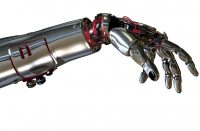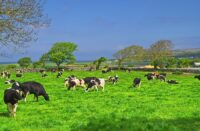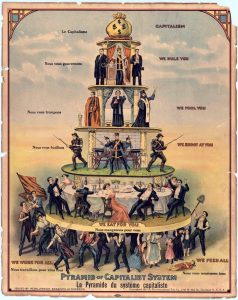In this series on the Capitalist Illusion I have tried to expose as clearly and plainly as possible the exploitative class nature of the capitalist system at the level of both the individual worker and internationally. The next task is to clearly understand how all this is facilitated within borders, structures and laws, created by citizens of a state, in order for us to further understand the exploitative system and its ability to perpetuate itself.
When dealing with the state it would do well for readers to read Lenin’s book The State and Revolution (from which I have taken some extracts). Even though it’s more than a hundred years old it’s as relevant now in Ireland as it was in Russia in 1917.
The modern state of the western capitalist model comes in many forms, but generally it has a central government to develop, oversee and implement state policy and law. It has a judiciary to oversee and apply the law. It has a form of law enforcement, i.e. police and secret service, etc., to ensure that people abide by the law; it has courts and a prison system to ensure that those who don’t abide by the law are punished or penalised; and the modern state will have some form of armed forces to protect its borders and, in some cases, to extend its sphere of influence.
Within all these institutions there is an army of civil servants, who take on the function of running and maintaining state policy.
Conventional thought would say that from these structures stems the rest of society, organised in different areas, ways, and means, including agriculture and industry, services to education, and everything in between.
There are those who are employers, and those who are employable, those who are dependent and those who are independent; and all must abide by the law of the land, whereby each member and each section of society is equal, has access and is able to direct state affairs through the democratic procedures and practices that have been established.
This summary of the state defines it as a neutral actor, a steward between all the various strands and groups in society, acting above and outside classes. However, this too is another illusion, perpetuated throughout our society, only becoming convention because the true nature of the state is camouflaged by those very powers that have and control state power.
The premise we need to begin with, in reference to the state, is that, as Lenin explained, “bourgeois states are most varied in form, but their essence is the same: all these states, whatever their form, in the final analysis are inevitably the dictatorship of the bourgeoisie.”
The conclusion reached here by Lenin is worthy of some thought, because understanding this will allow us to understand the class nature of the state, thereby shattering the illusion that the state is an arbitrary actor and allowing us, as a class, to expose the class nature of the state for those who are still spellbound by its illusion. To do this it is important at this stage that we give a brief outline of political economy, notably using Oskar Lange’s writings on the subject as a frame of reference, in order for us to embed our analysis and critique in Marxist theory.
We as a species have adapted our natural world (resources) to satisfy our needs and wants and have gone through various stages of historical development—from slave to feudal to capitalist. The activity of creating goods is known as production, and human labour is the effort and time an individual contributes to producing goods or services. Products are goods resulting from production, and our activity in the material world is part of the social process of production, which determines the productive relations, which in turn determine the distribution relations.
The ownership of the means of production (factories, ports, railways, roads, tools, resources, etc.) determines how labour is organised, divided, and put to use (productive relations) and how, through exchange mechanisms, goods meet our needs (distribution relations). The ownership structure determines who owns the products, hence who decides how they are distributed.
Ownership can be either private or social. If it is private it belongs to an individual or group, such as a family or company, and does not include every member of society. If it is social it is the common property of all citizens, and so its production and distribution are directed by all members of society, or those mandated by society, to meet the needs of all members of society.
The production and distribution of goods and services has developed over time. Historically there have been five basic modes of production: primitive communal, slave, feudal, capitalist, and socialist. These modes have either been antagonistic or non-antagonistic. They have also developed through transitional stages, a mix of modes, where remnants of the old society persist and survive in the new dominant mode of production; think of Britain’s (capitalist) parliamentary democracy under a (feudal) constitutional monarchy.
In antagonistic modes (slave, feudal, capitalist) not all members lay claim to the ownership of the means of production. This causes a split in society into distinct groups, which we label classes. In a capitalist society there are those who own the means of production (capitalists) and those who operate the means of production (labour).
These two classes have interests that are antagonistic to one another, because the share of total wealth of capital and labour expands at the expense of the other; however, it is only the capitalist class that actually don’t create wealth, they only take ownership of it. Labour, the productive mass of the people, in their relationship to the means of production create the wealth, which is appropriated by the capitalist.
Only one of these classes is actually necessary for the production of goods and services to meet the needs and wants of society.
It is vital at this stage that we make this distinction—that class is a relationship rather than a category construct—so that when we make reference to class we think of it in these terms: the relationship between the individual and the ownership of the means of production.
This is the distinguishing feature that separates the working class from the capitalist class. The wage system that exists in capitalist countries, the category that many people mistake as defining class, we must remember is a capitalist construct, developed by capitalists, and is in existence in order for the capitalist to be able to get more value from the worker than they pay them in wages—a non-equivalent exchange—without the worker being conscious of the fact that they are being exploited.
■ Part 2 of this article will be published in March.







